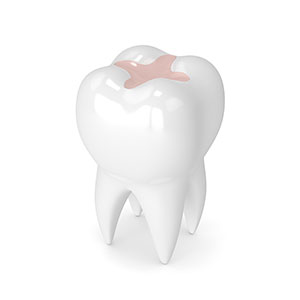
Although dental decay has been steadily decreasing in Canada for the past 40 years, dental fillings are still a very common and essential part of dentistry.
What is a dental filling?
A dental filling is used to replace tooth structure lost due to cavity or a broken tooth. Your dentist has to remove the decay and prepare the tooth before placing the dental filling. Dental fillings allow for a damaged tooth to be returned to its original shape and function.
What materials do dentists use for dental fillings?
Composite resin– This aesthetically appealing, tooth-coloured material is the most common product used for dental fillings. Composite fillings are bonded directly to the tooth, so less tooth structure needs to be removed than with amalgam fillings. Composite fillings typically last five to seven years but could last even longer.
Amalgam– Also known as a silver or metal filling, this filling material is not as frequently used anymore. Amalgam fillings tend to last longer than composite resins but do require more tooth structure to be removed during the preparation. Amalgams expand and contract at a different rate than our teeth, and over time this can make the teeth more likely to fracture.
Gold– Gold is very compatible with the oral environment and lasts a long time, but is expensive and not as aesthetically appealing as a tooth-coloured filling. Gold fillings are made in a dental lab.
Porcelain– Both gold and porcelain dental fillings are also known as inlays (fits between the cusps of a tooth) and onlays (covers the cusps of a tooth). Since they are made in a dental lab, it requires more than one dental visit to complete these types of fillings. Porcelain fillings are matched to your tooth, so they are aesthetically appealing and can last many years. The cost of porcelain fillings is similar to gold.
What to expect during your dental filling
Assessment– Your dentist will perform a thorough cavity check that may include x-rays. There are areas between your teeth that are not visible just by looking into your mouth. Without x-rays, some cavities may not be detected until they are more significant and severe.
Local Anesthetic– Before starting the dental filling procedure, the dentist will freeze the area so that you are comfortable. Your comfort is their top priority, and you can be given additional freezing as needed at any point during the procedure.
Preparing the tooth– The dentist has to remove the area of the tooth that is decayed. This is done using a dental drill or a laser. Removing all the decay is essential to prevent a cavity from recurring under the dental filling.
Filling the tooth– Once all the decay is removed, the dentist will use one of the above filling materials to return the tooth to its previous shape and function.
After a filling– Until the freezing wears off, care should be taken when chewing or eating anything hot. You could bite your tongue or cheek or burn your mouth without realizing it. Some people experience increased short-term tooth sensitivity after a dental filling. If your bite feels off or if you have difficulty chewing in the area, the filling could be high and need some small adjustments. Call your dentist if you suspect this.
If you have a broken tooth or suspect you have a cavity, you might need a dental filling. Delaying having a dental filling may result in requiring a more extensive and more costly dental treatment down the road. Booking a dental exam is an excellent first step to knowing what your dental needs are and reaching your oral health goals. Call us today to learn more or if you are in need of a dental filling!
